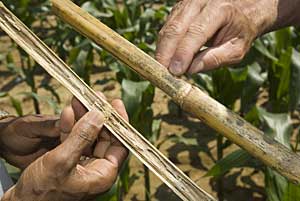 |
|
Comparison between a hybrid with the Anthracnose stalk
rot resistance trait (left) next to a hybrid susceptible
to the disease.
Photo from
Pioneer Hi-Bred |
Newark, Delaware
February 11, 2009
The
University of Delaware announced today that it has reached a
commercial agreement with DuPont
regarding their multi-year, corn disease resistance research
collaboration. Terms of the agreement were not disclosed.
DuPont seed business
Pioneer Hi-Bred now is
marketing Pioneer® brand hybrid 34F26, the first corn hybrid in
North America to carry the trait, which provides enhanced
resistance to anthracnose stalk rot. Additional hybrids carrying
the trait are being evaluated for 2010.
“We're thrilled to see the discoveries of University of Delaware
(UD) scientists being put to work for farmers through our
collaboration with DuPont,” said Patrick Harker, University of
Delaware president.
James A. Hawk, UD professor of plant and soil sciences, became
familiar in the 1980s with a gene in corn known to provide
resistance to the fungus Colletotrichum graminicola, which
causes the often devastating disease anthracnose stalk rot
(ASR). At the time the gene was found only in a “tropical” corn
line from Mississippi, which could not be used commercially.
Hawk worked for more than 20 years to demonstrate that the gene
could be bred into commercial germplasm and developed
“near-isogenic lines” that facilitated the genetic
characterization of ASR resistance. He and his associates then
teamed up with DuPont scientists and cutting-edge technology was
used to “fine map” the gene and develop molecular markers under
a Collaborative Research Agreement between DuPont and the
University. DuPont scientists are using those markers in high
throughput genetic technology to move the gene into a wide
variety of elite commercial germplasm. Intellectual property
protection is pending on the discoveries of the collaboration
and the corn lines developed by Hawk.
“Bringing additional disease resistance to our customers is part
of our overall strategy to increase their productivity,” said
Paul E. Schickler, president -- Pioneer and vice president and
general manager -- DuPont.
The increased incidence of anthracnose stalk rot is thought to
be associated with increased use of no-till agricultural
practices that are utilized to reduce soil erosion and fuel
costs. Higher risk of the disease also is associated with corn
planted in fields that had corn the previous year because the
pathogen over-winters in corn residue. Yield losses due to the
disease, estimated to be about $1billion annually in North
America are the result of reduced ear size, premature plant
death and stalk breakage of the plant below the ear, all of
which decrease harvestable yield.
 |
|
Corn
without resistance to the fungus Colletotrichum
graminicola can be attacked by the devastating disease
anthracnose stalk rot.
Photo by Kathy F. Atkinson |
Anthracnose stalk rot typically
rots corn stalks from the bottom, causing the stalks to break
over or ears to fall off completely, making harvest much more
difficult. The disease also can kill the plant from the top
down, a trait called top dieback, which results in premature
plant death and reduced yields.
The technology developed by UD and DuPont adds to the arsenal of
tools farmers can use to combat this disease and protect corn
yields. A portion of the royalties to the University from sales
of the ASR resistant hybrid will be reinvested in support of
continuing research at UD.
® Registered trademark of Pioneer Hi-Bred.
Tracing its heritage back to 1743, the University of Delaware
is a state-assisted, privately controlled institution of higher
education with an enrollment of more than 16,000 undergraduates,
3,500 graduate students and 1,000 professional and continuing
students. UD offers degrees in a broad range of disciplines
across seven colleges, and is a land-grant, sea-grant,
space-grant and urban-grant institution. |
|
 |
|
James A. Hawk (right),
professor of plant and soil
sciences, and research associate
Teclemariam Weldekidan examine a
diseased corn stalk.
Photo by Kathy F. Atkinson |
|